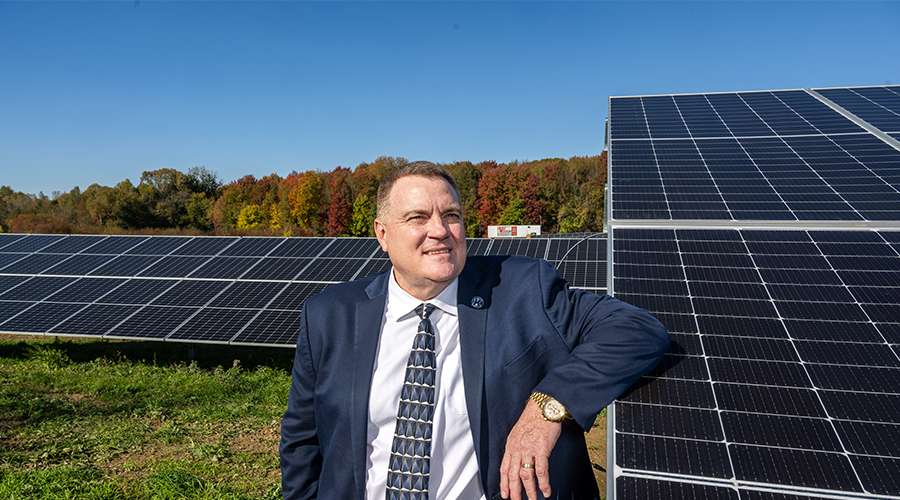Managers Discuss Strategies for Determining an Energy Baseline
By Chris Matt, Managing Editor - Print & E-Media
*Michael Zanghi, Director of Facilities, Highland Hospital, Rochester, N.Y.
*Volkert Braren, Director of Program Management, New York City Department of Education – Division of School Facilities
*Jay Russell, Mechanical Engineer Lead, University of Michigan – Plant Operations, Ann Arbor, Mich.
Implementing energy-efficiency initiatives has become standard practice for maintenance and engineering departments in commercial and institutional facilities.
But before managers tackle these initiatives, they are benchmarking their facilities' energy use to assess their performance and develop a conservation strategy that boosts the bottom line.
What first steps did you take to benchmark energy use?
ZANGHI: The first step was to really learn more about the benchmarking process. I learned through some of my professional contacts in other organizations about the (U.S. Environmental Protection Agency's) Energy Star benchmarking process. Once I learned about it and was involved in putting it together, then it was more about getting the information that we had in the organization.
BRAREN: The first steps we took were basically looking at what type of benchmarking system or solution would work best for us. We had thought about developing an in-house benchmarking process, and we looked at other software solutions, as well as (Energy Star) Portfolio Manager. We decided that Portfolio Manager, because it was already semi-customized for K-12 schools, would perhaps best meet our overall goals.
RUSSELL: I would say the cornerstones of benchmarking involved having separate utility meters in individual buildings and having building-automation systems installed in individual buildings, as well, to help provide more detailed information on trending and troubleshooting.
What were the biggest benchmarking challenges?
BRAREN: We're still validating and verifying information. Among the biggest challenges we had was, that as an organization, we never gathered gross square-footage information. Our organization, for probably 100 years, has only tracked net square footage. Just getting gross square footage was mind-boggling for 1,200-plus buildings.
RUSSELL: In our case, the campus has a large number of buildings, and there's a wide variety of different types and sizes of buildings. Even for buildings of similar types, whether it's labs or classrooms, there is a lot of variation in space programming. Of course, variations due to weather can be significant from year to year. All in all, these variations made it pretty challenging to generate specific actions or direction based on broad comparisons to campus-wide or nationwide averages. To overcome that, we've been developing weather-adjusted energy baselines for individual buildings and trying to tailor our conservation efforts to the unique character of every building.
ZANGHI: It's basic information that you need to pull together. Depending on how well the organization has its data pulled together prior to the benchmarking process, it really affects how long it takes to do it. Square footage is a prime metric. Sometimes, matching the meter data with the square-footage data (can be a challenge).
What was your role in the benchmarking process?
RUSSELL: First, I'm involved with utility metering and billing. I'm also involved with operations of steam and chilled-water systems around campus and a number of energy-conservation activities. With regards to benchmarking, I've helped develop our approach for establishing these weather-adjusted energy baselines and providing feedback on energy performance to administration, building occupants, and maintenance people.
ZANGHI: As the director of facilities, my role is to actually make the benchmarking happen — to get the people with the data to get it into the system, get the results of that (process), and relay that up to the organization's administrators. There's day-to-day stuff in terms of benchmarking — getting square footage, energy data, and the meter readings. All of that goes into the system, and then you get a result from that. My role is to publicize that result and take action based on the result.
BRAREN: I was one of the key persons in deciding to use Portfolio Manager, as opposed to using something in-house. I was, more or less, the managerial point person for (the process).
For what systems was it most difficult to determine an energy baseline?
ZANGHI: I don't think any of them were overly difficult. Matching the meter data to the square footage was probably the most difficult component.
RUSSELL: Our utility metering is generally done at a building level, rather than a system level, for the most part — there are some exceptions. There are certain building types that are pretty challenging to determine energy baselines.
BRAREN: We had the information on energy used, in terms of fuel, gas, steam and electric. The question was not so much what systems were difficult because we had the information. There are still a few sites that are more difficult because they are supplied steam on an un-metered basis. We have a specification request to determine the best way of metering those few sites that are nebulous because of where some of their information comes from.
What did energy benchmarking reveal about the energy performance of systems and facilities?
BRAREN: It confirmed suspicions that we had that we could improve dramatically. It's a lot easier to look at a building when it has a rating that says, "You have real room to improve this building," and to be able to go out to somebody and say, "Here you go. Look at this, and tell me why or what (is causing its performance)."
RUSSELL: It's different for each building. We're learning that there are definitely places we need to improve. And we're learning that there are places where conservation opportunities are limited. The benchmarking efforts have given us the feedback to make that determination. We've also been able to demonstrate how energy intensive air-conditioning systems can be during summer months, which reinforces the need for efficient chillers and control strategies.
ZANGHI: We are Energy Star-rated, so that shows that there's a little bit smaller of a window for improvement. We are continuing to look at possibilities for energy improvement. It depends where you are on the (energy-performance) scale as to whether you have a big opportunity or a small opportunity.
What did energy benchmarking reveal about the way your department maintains building systems?
RUSSELL: As far as specific systems, looking at the results of energy benchmarking has helped reinforce or underline the importance of maintaining our steam systems in particular. That would include regular trap testing and replacement and condensate-quality testing. The cost of trap failures and heat-exchanger failures can be large and therefore justify a more proactive approach.
ZANGHI: I didn't see anything that related specifically to maintenance. I think the infrastructure, building design, and other fixed components really had a bigger contribution to the overall energy rating.
BRAREN: We knew that we had a number of different issues with controls, particularly on the steam side, that would be highlighted by (benchmarking). The temperature-control systems and the traps were not necessarily being well maintained. (Benchmarking) tended to confirm that. We definitely can see that there are areas that can be improved, in terms of controls.
What changes did you make related to the maintenance of those systems?
RUSSELL: Going back through history, we were doing group trap replacement. We've started to emphasize ultrasonic trap testing and trap-database management and have had good results. Another area would be heat-exchanger maintenance and replacement. Other steam-system improvements include controls optimization for absorption chillers and steam control valves.
BRAREN: It's difficult, given the budget cuts that we've had over the last couple of years and that we expect again this year, to develop a program that addresses all of the issues that get revealed.
Based on the results, what actions did you take to improve energy efficiency?
ZANGHI: One of the projects that we are moving forward with is a retrofit of our parking-garage lighting. We're going to go from HID (high-intensity-discharge) lighting to florescent technology in our garages.
BRAREN: We're working with the city unit that handles energy. There are two things going on there — a metering and monitoring master project and a separate electrical-metering project. We're working with them to identify what systems will gain the most benefit from having more detailed energy monitoring.
RUSSELL: Basically, the actions over time have included lighting upgrades, variable-speed drives for many motors in our HVAC systems, controls upgrades, and a wide variety of other projects and recommissioning activities. Our most recent energy-conservation efforts have been performed under what we call the Planet Blue program. The core energy-conservation activities of that program are energy audits for individual buildings, recommissioning the HVAC and control systems, and other maintenance items, such as steam-trap testing.
What plan do you have in place to measure ongoing energy use?
RUSSELL: We will continue to monitor and meter individual utilities in individual buildings. The Planet Blue program has a component of going back and relaying the results of these activities to the building occupants. What it does is, it closes the loop on energy-conservation activities and helps focus on what's making a difference.
ZANGHI: We continually use Energy Star. Each year, we've applied for Energy Star, and we plan on doing that in the future. We'll watch any trends within our benchmarking.
Related Topics:











